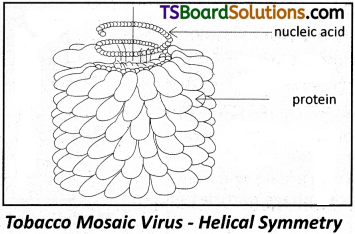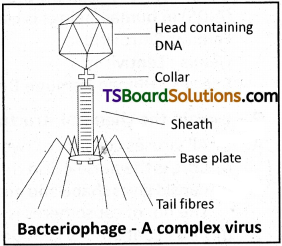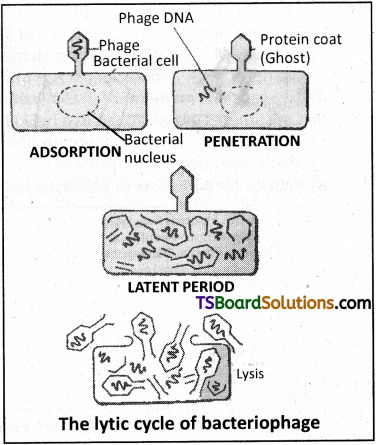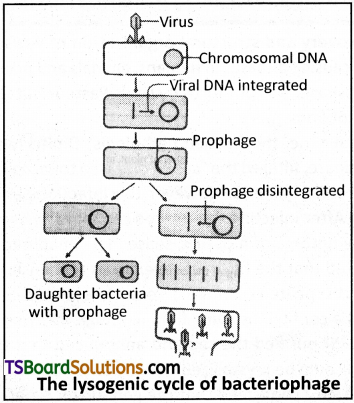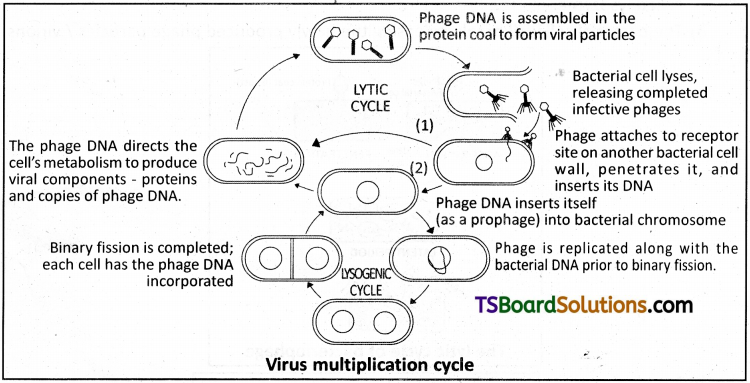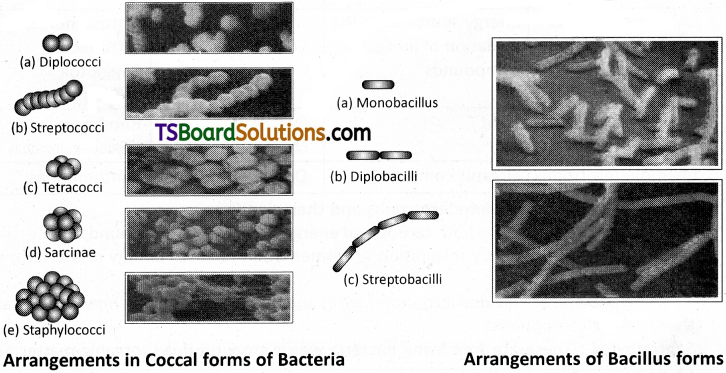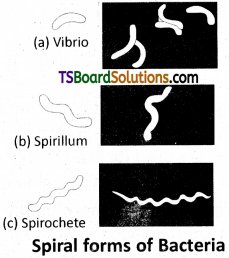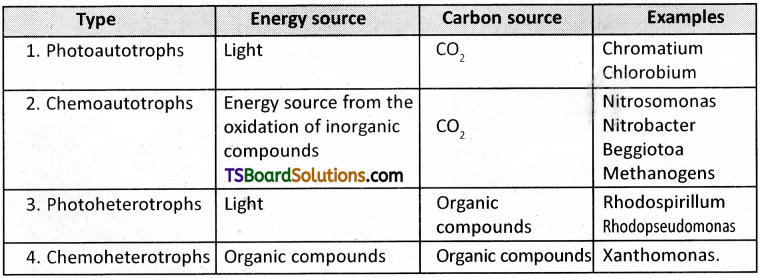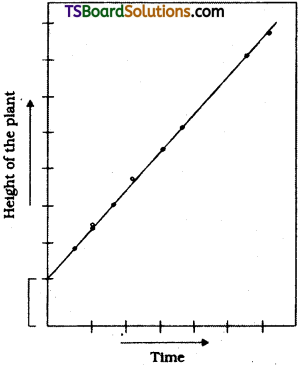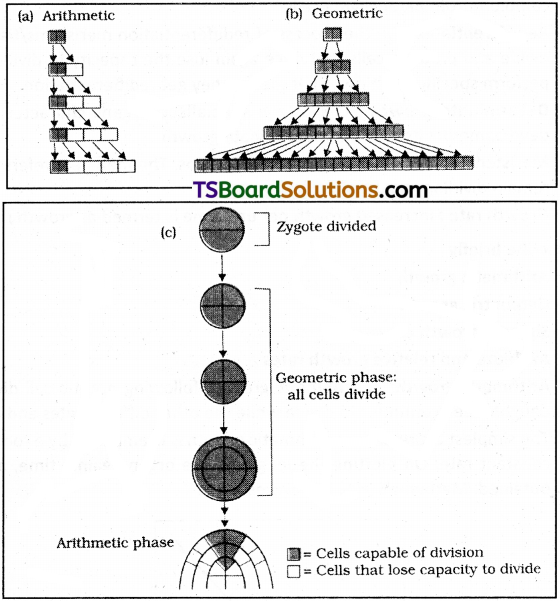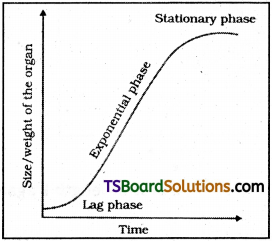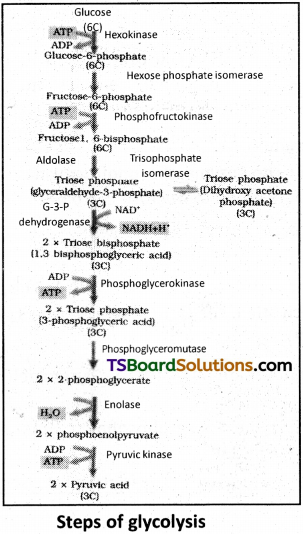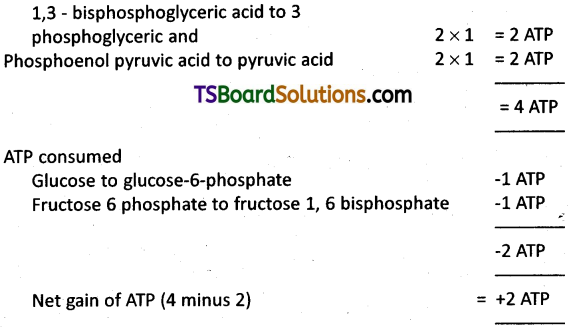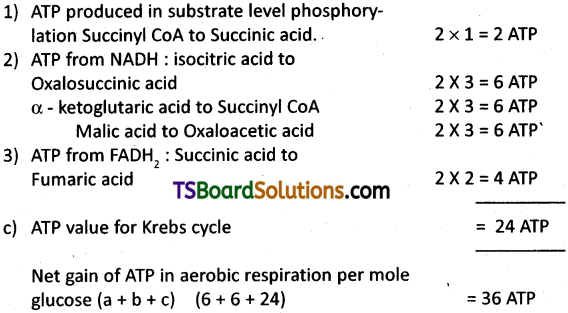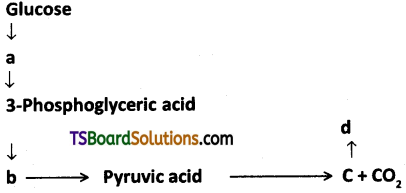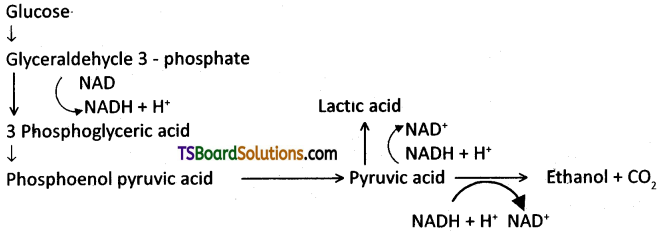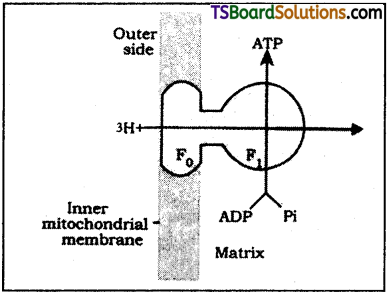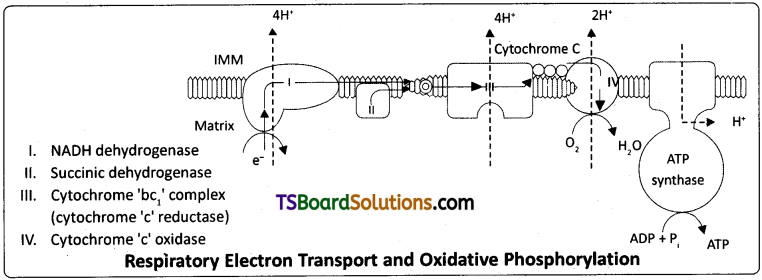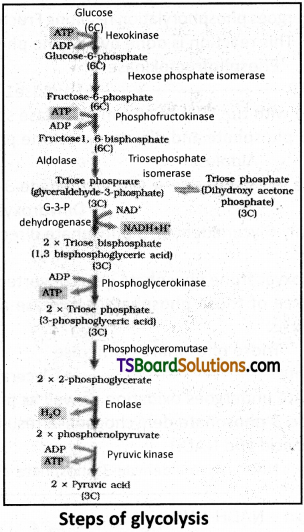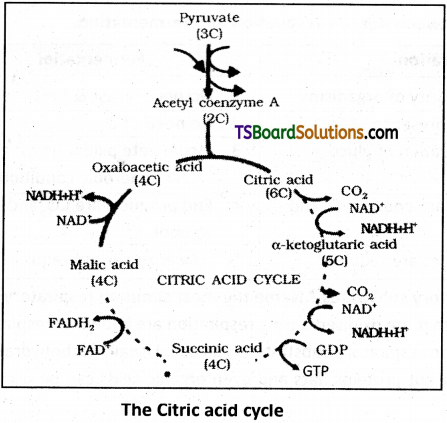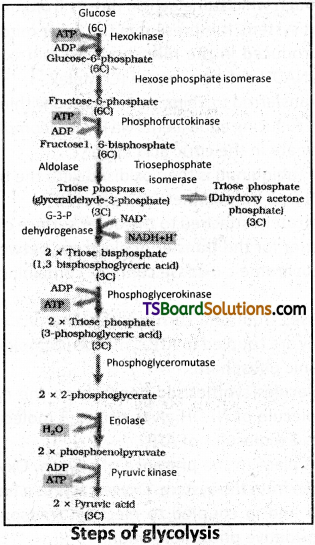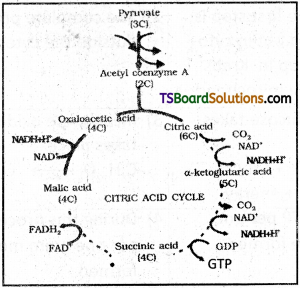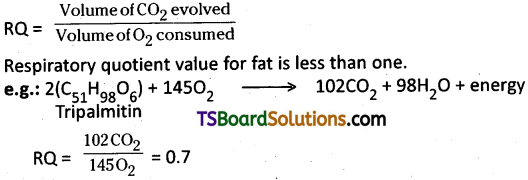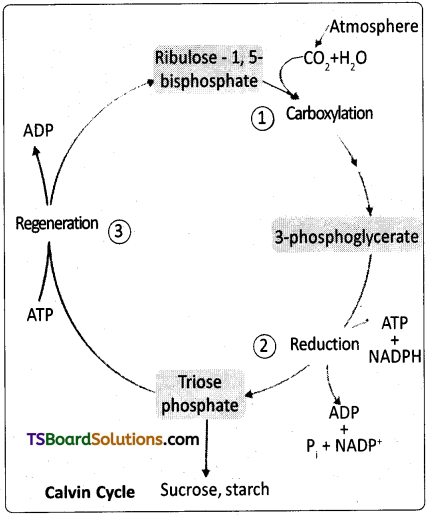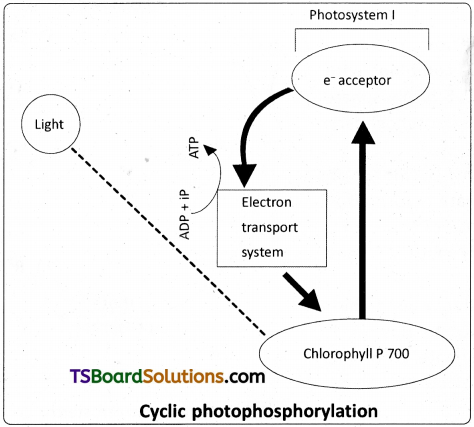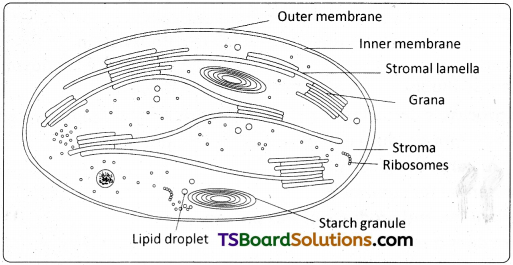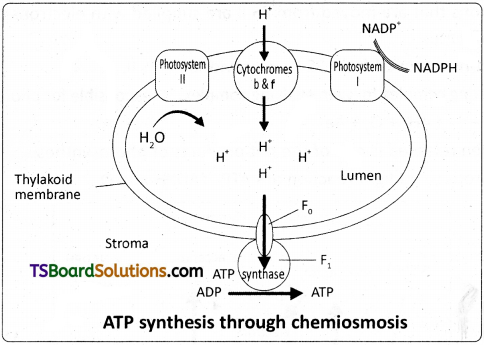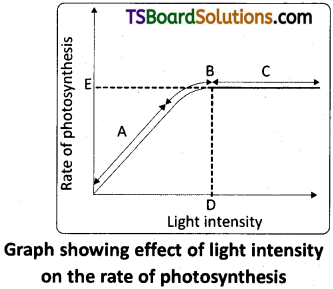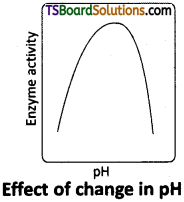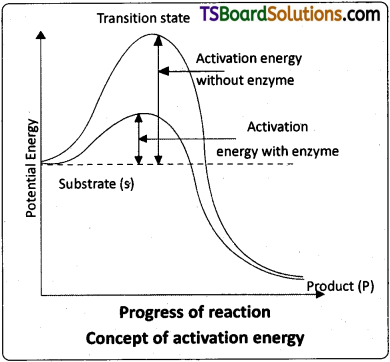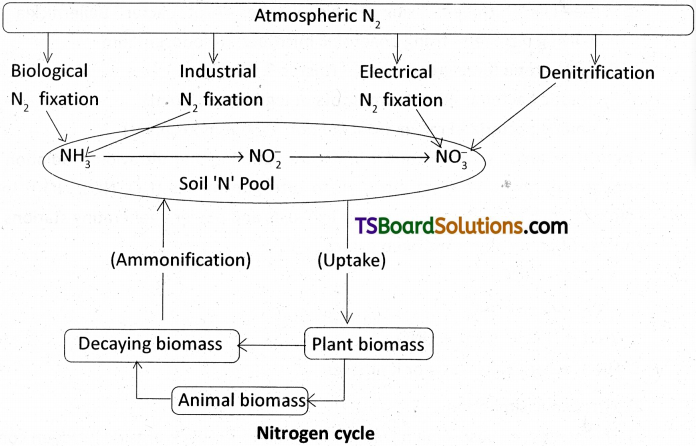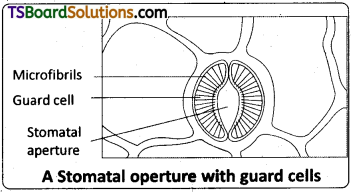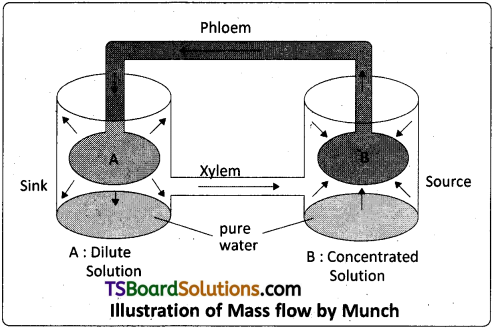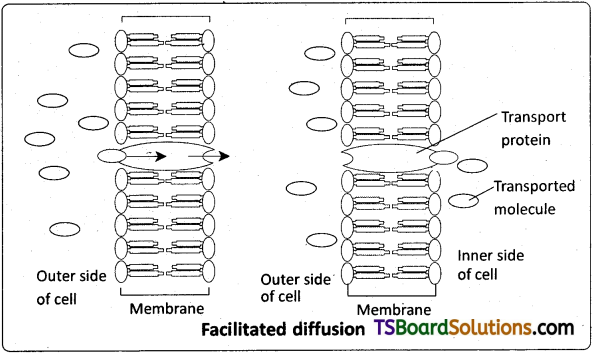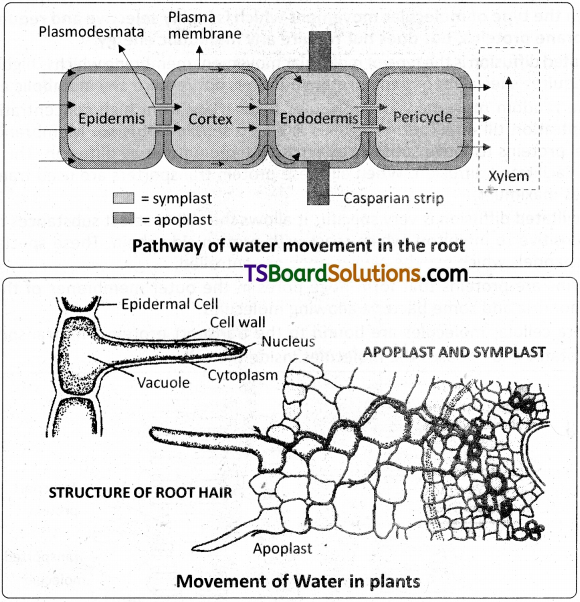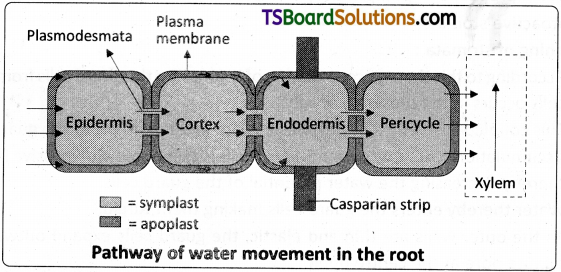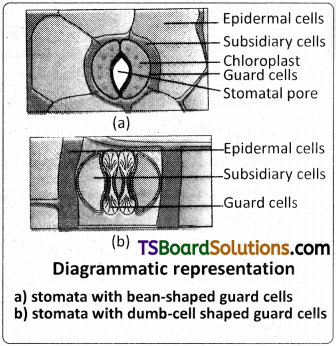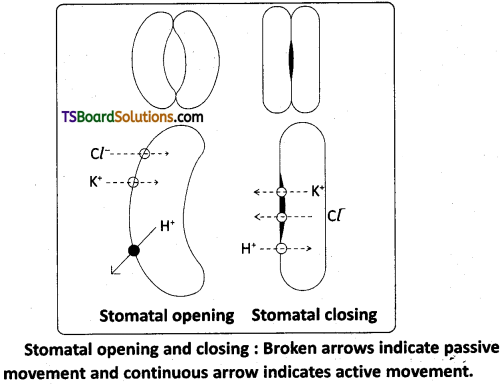Telangana TSBIE TS Inter 2nd Year Botany Study Material 9th Lesson Principles of Inheritance and Variation Textbook Questions and Answers.
TS Inter 2nd Year Botany Study Material 9th Lesson Principles of Inheritance and Variation
Very Short Answer Type Questions
Question 1.
What is the cross between the Fa progeny and the homozygous recessive parent called? How is it useful?
Answer:
- The cross between the Ft progeny -having dominant phenotype and the homozygous recessive parent is called Test cross.
- The progenies of such a cross can be easily analysed and the genotype of the test organism can be determined.
Question 2.
Do you think Mendel’s laws of inheritance would have been different if the characters that he chose were located on the same chromosome?
Answer:
- Yes, Mendel’s law of independent assortment would not be true for the genes that are located on the same chromosome.
- Linkage refers to the physical association of genes on a chromosome and are called linked genes.
Question 3.
Who proposed the Chromosome theory of Inheritance? [Mar. 2019, 17]
Answer:
- Walter Sutton and Theodore Boveri.
- They used chromosomal segregation during meiosis to explain Mendel’s laws.
Question 4.
Define true breeding. Mention its significance.
Answer:
- A true breeding line is one that has undergone continuous self pollination.
- It shows the stable trait inheritance and expression for several generations.
Question 5.
Explain the terms phenotype and genotype. [May ’17, Mar. ’14]
Answer:
- The physical or external appearance of a character (trait) is called phenotype.
- The genetic makeup of an individual is called genotype.
![]()
Question 6.
What is point mutation? Give an example. [Mar. ’18, May ’14]
Answer:
- The mutation that occurs in a single base pair of DNA molecule is called gene mutation or point mutation.
- A classical example for point mutation is sickle cell anemia.
Question 7.
A person has to perform crosses for the purpose of studying inheritance of a few traits / characters. What should be the criteria for selecting the organisms?
Answer:
- Organism must have well defined characteristics, can be grown and crossed easily.
- It possess bisexual flowers and can be self fertilized conveniently.
- It must have short life cycle and produce large number of offsprings.
Question 8.
In order to obtain the F1 generation, Mendel pollinated a pure-breeding tall plant with a pure breeding dwarf plant. But, to get the F2 generation, he simply self-pollinated the tall F1 plants. Why?
Answer:
- Pure breedingtall and dwarf plants are homozygous and give the same on self pollination. So he bred pure tall with pure dwarf to produce a hybrid.
- Mendel selfed the F1 to understand the inheritance of tall and dwarf characters and to know fate of suppressed trait in F2.
Question 9.
How are alleles of a particular gene differ from each other? Explain its significance.
Answer:
- Alleles are slightly different forms of the same gene ie., they differ by a single base pair.
- They are significant in understanding inheritance and behaviour of the genetic polymorphs.
Question 10.
In a monohybrid cross between red and white flowered plants, a geneticist got only red flowered plants. On self-pollinating these Ft plants, he got both red and white flow¬ered plants in 3 :1 ratio. Explain the basis of using RR and rr symbols to represent the genotype of plants of parental generation.
Answer:
- Red flowered plant crossed with white flowered plant gave red flowered F1 plant and hence red is dominant over white.
- In general, first letter of the dominant allele (Red) is used as symbol (R) to denote the genotype and its respective recesssive allele (white) is denoted by small letter (r).
![]()
Question 11.
What is the genetic nature of wrinkled phenotype of pea seeds? [Mar. 2020]
Answer:
- Wrinkled character of seed in pea is a recessive tract.
- Hence genotype of wrinkled phenotype for pea seeds is ‘rr’
Short Answer Type Questions
Question 1.
In a Mendelian monohybrid cross, the F2 generation shows identical genotypic and phenotypic ratios. What does it tell us about the nature of alleles involved? Justify your answer.
Answer:
Incomplete dominance :
It is the phenomenon in which neither of the genes is completely dominant or completely recessive. As a result, the hybrid shows intermediate character. For example, the inheritance of flower colour in the dog flower. (Snapdragon or Antirrhinum sp). The cross between true breeding (homozygous) red flower (RR) and true breeding (homozygous) white flower plant (rr) F1 (R r) was pink.
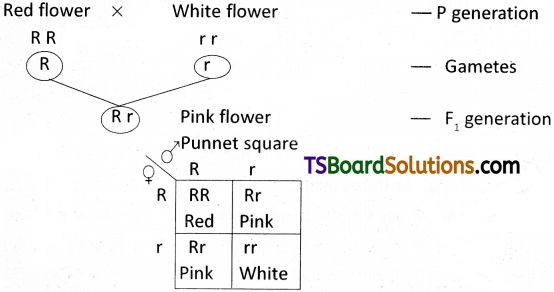
The phenotypic ratio deviates from Mendelian monohybrid ratio of 3 : 1 to 1 : 2 : 1 (Red flower – 1, Pink flowers – 2, White flower -1) since the heterozygous / hybrid shows a different phenotype genotype ratio remains the same as Mendelian ratio 1 : 2 : 1.
Question 2.
Mention the advantages of selecting pea plant for experiment by Mendel. [Mar. 2018, ’17 ’14]
Answer:
- It is an annual plant that has well defined characteristics.
- It can be grown and crossed easily.
- It has bisexual flowers containing both female and male parts.
- It can be self fertilized coveniently.
- It has a short life cycle and produces large number of offsprings.
Question 3.
Differentiate between the following :
a) Dominant and Recessive [Mar. 2020]
b) Homozygous and Heterozygous [Mar. 2020]
c) Monohybrid and Dihybrid.
Answer:
a) The character which is expressed in F1 generation is called dominant and that which is unexpressed is called recessive.
b) Parents carrying similar genes such as TT or tt are called homozygous and the parents with unlike genes like Tt are called heterozygous.
c) Cross involving two parents differing in only one character is called Monohybrid cross. For example, cross between tall (TT) and dwarf (tt) parents. Cross involving two parents differing in two characters is called a Dihybrid cross. For example, cross between pea plant having yellow round seeds (YYRR) with homozygous pea plant having green wrinkled seeds (yyrr).
![]()
Question 4.
Explain the Law of Dominance using a monohybrid cross. [May 2017]
Answer:
Mendel observed that in F1 hybrids the character of tallness dominated or supress the dwarf character. The character which is expressed in F1 generation is called dominant trait and that which remained unexpressed is called recessive trait.
Based on his observation on monohybrid crosses, Mendel proposed Law of Dominance.
Law of Dominance :
- Characters are controlled by discrete units called factors.
- Factors occur in pairs.
- In a dissimilar pair of factors pertaining to a character one member of the pair dominates (dominant) the other (recessive).
The Law of Dominance is used to explain the expression of only one of the parental characters in a monohybrid cross in the F1 and the expression of both in the F2. It also explains the proportion of 3 : 1 obtained at the F2.
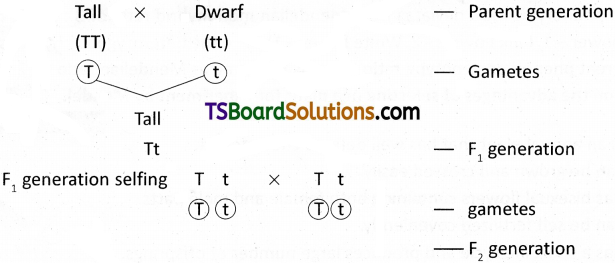
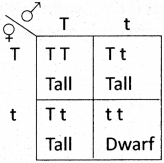
The phenotypic ratio is 3 Tall: 1 Dwarf.
The genotypic ratio is 1 TT, 2Tt, 1 tt.
Question 5.
Define and design a test -cross.
Answer:
- When the F1 individuals are crossed with the recessive parent or organism similar in phenotype and genotype to the recessive parent, it is called test cross.
- Test cross is used to test whether an individual is homozygous (pure) or heterozygous (hybrid).
- A monohybrid test cross gives a phenotypic ratio of 1 : 1
Monohybrid Test cross

Question 6.
Using a punnet square, work out the distribution of phenotypic features in the first filial generation after a cross between a homozygous female and a heterozygous male for a single locus.
Answer:
Punnett square is a graphical representation to calculate the probability of the offsprings.
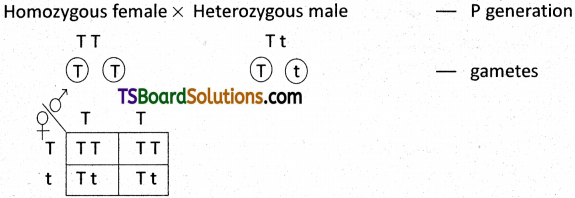
- No recessive individuals are obtained in the progeny.
- All the plants show phenotypically dominant character.
- They show a genotypic ratio 1 : 1.
- This is a test cross.
![]()
Question 7.
When a cross is made between tall plant with yellow seeds (It Yy) and a tall plant with green seeds (Tt yy). What proportion of phenotype in the offspring is expected to be
a) tall and green?
b) dwarf and green?
Answer:
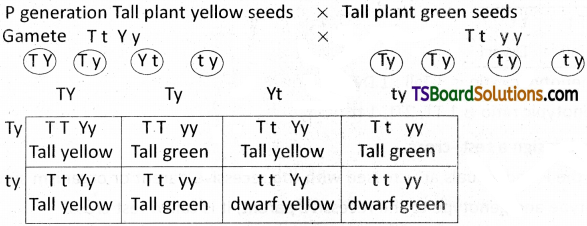
a) Tall and green – 3/S
b) Dwarf and green – 1/8
Question 8.
Explain the following terms with examples. [May 2014]
a) Co-dominance
b) Incomplete dominance
Answer:
a) Co-dominance :
It is the phenomenon In which both the genes are equally dominant and so the character of both genes is well expressed in next generation. So in F1 generation regeneration resemble both parents.
Examples are different types of red blood cells that determine ABO blood grouping in human beings and seed coat pattern and size in lentil plants.
Lentil is a major grain legume (pulse) crop in N. America, A cross between pure-breed- ing spotted (having a few big irregular pathes) lentils and pure breeding dotted (having several small circular dots) lentils produce heterozygotes that are both spotted and dotted. Thus it shows the phenotypic features of both parents, which means that neither the spotted nor the dotted allele is dominant or recessive to the other.
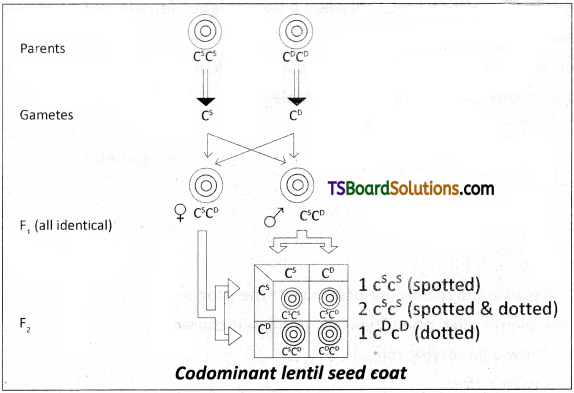
b) Incomplete dominance :
It is the phenomenon in which neither of the genes is completely dominant or completely recessive. As a result the hybrid shows intermediate character. For example, the inheritance of flower colour in the dog flower. (Snapdragon or Antirrhinum sp). The cross between true breeding (homozygous) red flower (RR) and true breeding (homozygous) white flower plant (rr) F1 (R r) was pink.
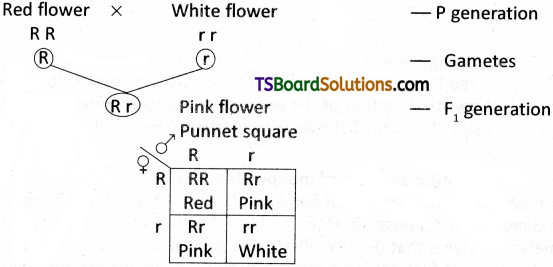
The phenotypic ratio deviates from Mendelian monohybrid ratio of 3 : 1 to 1 : 2 : 1 (Red flower -1, Pink flowers – 2, White flower -1) since the heterozygous / hybrid shows a different phenotype genotype ratio remains the same as Mendelian ratio 1 : 2 : 1.
Question 9.
Write a brief note on chromosomal mutations and gene mutations.
Answer:
Chromosomal Mutation :
Any change in structure and No. of chromosome is called chromosomal mutation.
- Loss or gain of a segment of DNA, results in alternation in chromosomes. Because genes are located on chromosomes, alteration in chromosomes results in abnormalities.
- Chromosomal alternations are common in cancer cells.
Gene Mutation :
Mutation that occurs due to change in a single base pair of DNA is called Gene Mutation or point mutation. E.g.: Sickle cell anaemia. Deletion and insertion of base pairs of DNA, Cancer from shift mutation.
Question 10.
How was it concluded that genes are located on chromosomes?
Answer:
Morgar hybridised yellow bodied and white eyed females to brown bodied, red eyed males and intercrossed their F1 progeny. He observed that the two genes did not segregate independently with each other and the F2 ratio deviated very significantly from the 9 : 3 : 3 : 1 ratio. He saw quickly that when the two genes in a dihybrid cross were situated on the same chromosome, the proportion of parental combinations was much higher than the non – parental type. He attributed this due to the physical association or linkage of the two genes and coined the term linkage and the term recombination to describe the generation of non parental gene combinations. He also found that, even when genes were grouped on the same chromosome, some genes were tightly linked and some genes were loosely linked.
Alfred Sturtevant used the frequency of recombination between gene pairs on the same chromosome as a measure of distance between genes and mapped their position on the chromosome.
Question 11.
A plant with red flowers was crossed with one having yellow flowers. If F1 showed all flowers in orange colour, explain the inheritance.
Answer:

The cross between red flower and yellow flower, showed all orange colour flowers in F1 generation. This shows that neither of the genes is completely dominant or completely recessive. As a result, the hybrid shows intermediate character. This is incomplete dominance.
Question 12.
Define Law of Segregation and Law of Independent Assortment.
Answer:
Law of Segregation or law of purity of gametes :
Based on the results obtained from the monohybrid cross Mendel postulated the first law “the law of segregation or law of purity of gametes.” It states that the two alleles of a gene when present together in a heterozygous state, do not fuse or blend in any way, but remain distinct and segregate during meiosis or in the formation of gametes so that each meiotic product or gamete will carry only one of them.
Law of Independent Assortment :
Based on the results of the dihybrid crosses in pea plant, Mendel postulated his second law known as “the law of Independent Assortment.” Which states that “when the plants differ from each other in two or more pairs of contrasting characters or factors, then the inheritance of one pair of factors is independent to that of the other pair of factors.
![]()
Question 13.
In peas, tallness is dominant over dwarfness and violet colour of flowers is dominant over the white colour. When a tall plant bearing violet flowers was pollinated with a dwarf plant bearing white flowers, different phenotypic groups were obtained in the progeny in numbers mentioned against them.
Tall, violet = 138 Dwarf, violet = 136
Tall, white = 132 Dwarf, white = 128
Mention the genotypes of the two parents and of the four offspring types.
Answer:
When a tall plant bearing violet flowers was pollinated with a dwarf plant bearing white flowers, the different phenotypic groups were in ratio nearly 1: 1:1: 1. This is Dihybrid test cross ratio. The genotype of two parents Tt Vv (Tall violet) and tt vv (Dwarf white) 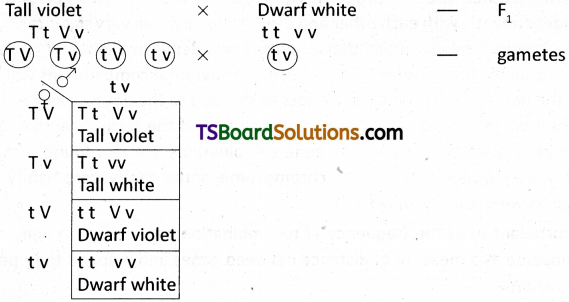
Question 14.
How do genes and chromosomes share similarity from the view point of genetical studies?
Answer:
Chromosomes are made up of DNA and proteins DNA is a special kind of molecules made up of nucleotides. There are four types of nucleotides. A DNA molecule consists of a long string of nucleotide pairs linked together. The sequence of nucleotide forms a code gene refer to a specific sequence of this DNA code that actually means characters all genes are DNA but not all the DNA are the genes.
Chromosomes are DNA molecule made up of a sequence of nucleotides. Genes are stretches of DNA that contain code to make protein. Thus both chromosome and genes are similar from the point of genetic studies.
Question 15.
With the help of an example differentiate between incomplete dominance and com-plete dominance.
Answer:
Incomplete dominance :
It is the phenomenon in which neither of the two alleles of a gene is completely dominant over the other.
- The inheritance of flower colour in dog flower / snap dragon (Antirrhinum majus) and that in Mirabilis jalapa (4 o’ clock plant) are examples of this phenomenon.
- When a cross is made between a red flowered plant with a white flowered plant of snap dragon the F1 hybrid has pink flowers.
- When the F1 individual was self pollinated and an F2 raised the F2 contained individuals bearing red, pink and white flowers.
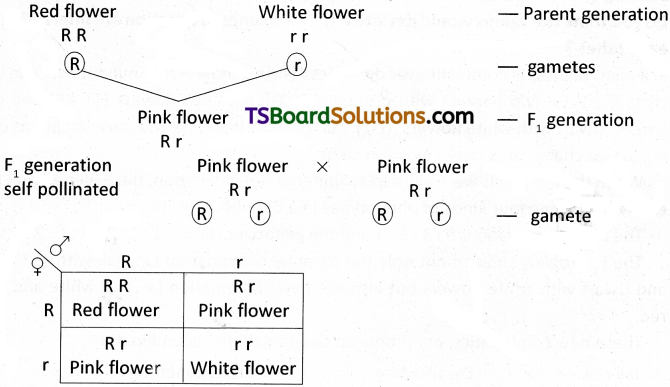
The phenotypic and genotypic ratio are same i.e., 1 Red : 2 Pink : 1 White.
Complete dominance is a phenomenon in which one allele of a gene expresses itself and suppresses the expression of the other allele of the same, when they are present to-gether in a hybrid.
- When a cross was made between two individuals, one with tall stem (homozygous) and the other with dwarf stem, F1 individual had tall stem.
- When a F1 individual is self pollinated the F2 produced tall and dwarf individuals in the ratio of 3 : 1
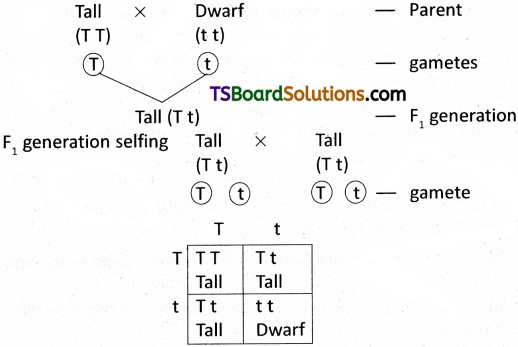
The phenotypic ratio is 3 Tall : 1 Dwarf.
The genotypic ratio is 1 TT : 2 T t: 111.
Long Answer Type Questions
Question 1.
In a plant, tallness is dominant over dwarfness and red flower is dominant over white. Starting with the parents workout a dihybrid cross. What is standard dihybrid ratio? Do you think the values would deviate if the two genes in question are interacting with each other?
Answer:
In a plant tallness is dominant over dwarfness and red flower is dominant over the white cross between two parents with one parent, Tall with red flowers (TT RR) and other parent, Dwarf with white flowers (tt rr). Such a cross involving two parental plants differing in two character is called dihybrid cross.
When the F1 hybrids were allowed to undergo self pollination, the F2 generation progeny was showing four kinds of phenotypes in a definite pattern.
The phenotypic ratio is 9 : 3 : 3 : 1 and the genotypic ratio is 1 : 2 : 2 : 4 : 1 : 2 : 1 : 2 : 1.
The F2 progeny showed not only the parental combination i.e., Tall with red flowers and Dwarf with white flowers but also the new combination i.e., Tall white and Dwarf red.
These new combination are produced due to genetic recombination.
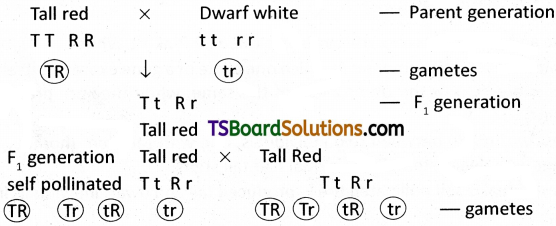
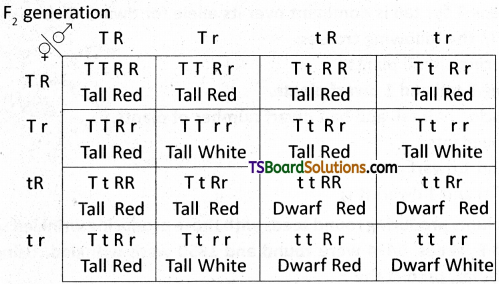
The F2 progeny are Tall purple 9 ; Tall white 3 ; Dwarf purple : 3; Dwarf white 1.
The dihybrid ratio is 9 : 3 : 3 : 1.
Yes, the values would deviate if the two genes interact with each other.
Intext Question Answers
Question 1.
What will be the phenotypic ratio in the offsprings obtained from the following crosses,
a) Aa × aa b) AA × aa c) Aa × Aa d) Aa × AA
Note : Gene ‘A’ is dominant over gene ‘a’.
Answer:
a) Aa × aa – P generation

The progeny shows 1 : 1 ratio.
b) AA × aa – P generation
![]()
The progeny shows Aa hybrid.
c) Aa x Aa – P generation
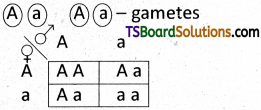
The progeny shows 1 : 2 : 1, 1 AA : 2 Aa : 1 aa genotype, 3 : 1 phenotype.
d) Aa × AA – generation
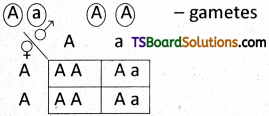
All the progeny shows dominant character.
Question 2.
In garden pea, the gene T for tall is dominant over its allele for dwarf. Give the geno-types of the parents in the following crosses.
a) tall × dwarf producing all tall plants.
b) tall × tall producing 3 tall and 1 dwarf plants.
c) tall × dwarf producing half tall and half dwarf number of plants.
Answer:
a) TT × tt → Tt all tall plants.
b) Tt × Tt → 3 tall and 1 dwarf plant.
c) Tt × tt → 1 tall (T t) and 1 dwarf (t t)
![]()
Question 3.
Mendel crossed pea plants producing round seeds with those producing wrinkled seeds. From a total of 7324 F2 seeds, 5474 were round and 1850 were wrinkled. Using the symbols R and r for genes, predict the :
a) the parental (p) genotypes
b) the gametes
c) F2 progeny
d) the cross between F hybrids
e) genotypes, phenotypes, genotypic frequency, phenotypic ratio of F2 progeny.
Answer:
a) The parental genotypes are RR, rr (homozygous).
b) The gametes are (R) and (r).
c) F1 progeny gene R r.
d) Cross between F1 hybrids are R r × R r.
e) Genotypes are 3
Phenotypes are 2
Genotypic frequency 1 : 2 : 1
Phenotypic ratio is 3 : 1
Question 4.
The following data was obtained from an experiment on peas. The grey coloured seed is dominant over white coloured seed. Use the letter G for grey and g for white traits. Predict genotypes of the parents in each of the following crosses.
| Parent | Progeny | |
| Grey | White | |
| a) Grey × white | 164 | 156 |
| b) Grey × grey | 59 | 19 |
| c) White × white | 0 | 100 |
| d) Grey × grey | 180 | 0 |
Answer:
a) Genotypes of the
Grey × white
Gg × gg
b) Grey × grey
Gg × Gg
c) White × white
gg × gg
d) Grey × grey
Gg × GG
Question 5.
In tomatoes, red fruit colour (R) is dominant to yellow (r). Suppose a tomato plant homozygous for red is crossed with one homozygous for yellow. Determine the appearance of the following.
a) the F1 b) F2, c) the offspring of a cross of the F1 back to the red parent
d) the offspring of a cross of the F1 back to the yellow parent.
Answer:
a) The appearance in F1 are all red (Rr).
b) The appearance in F2 are 3 : 1 (3 red; 1 yellow).
c) The appearance of the offspring of a cross of the F2 back to the red parent are all red (homozygous red and heterozygous red). It is back cross.
d) The appearance of the offspirng of a cross of the F1 back to the yellow parent are red and yellow in 1 : 1 ratio. It is test cross.
Question 6.
In pea, axillary position of flowers (T) is dominant over its terminal position (t). Coloured flowers (C) are dominant to white flowers (c). A true breeding plant with coloured flowers in axils is crossed to one with white terminal flowers. Give the phenotypes, genotypes and expected ratios of F2, F2 back cross and test cross progenies. What genotypic ratio is expected in the F2 progeny?
Answer:
Axillary coloured flowers × Terminal white flowers – P
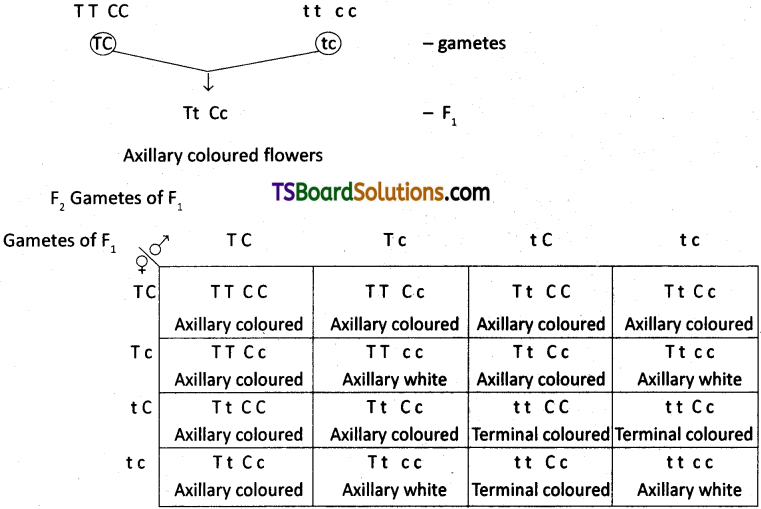
All the F1 hybrids phenotypes are found to have Axillary coloured flowers.
All the F1 hybrids genotypes are T t Cc.
The phenotype ratio of F2 are 9 : 3 : 3 : 1.
The genotype ratio of F2 are 1 : 2 : 2 :4 : 1 : 2 : 1 : 2 : 1.
Dihybrid test cross ratio is 1 : 1 : 1 : 1
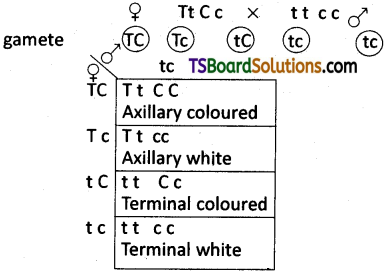
In back cross when F2 individuals are crossed with the parent having dominant traits no recessive individuals are obtained. All are Axillary coloured flowers.
Question 7.
In summer squash, a plant with white flowers and disc-shaped fruits is crossed to a plant with yellow flowers and sphere shaped fruits. The F1 hybrids had white flowers and discshaped fruits. Which phenotypes are dominant? Give the genotypes of the parents and the hybrids. If these hybrids are selfed and 256 progeny are obtained. What would be the frequencies of the various phenotypes?
Answer:
The dominant phenotypes are white flowers with disc shaped fruits.
The dominant white flower (W) and recessive yellow flower (w).
The dominant disc shaped fruit (D) and recessive sphere shaped fruit (d).
The genotype of parents WWDD (white flowered disc shaped fruits) and wwdd (yellow flower and sphere shaped fruits).
The genotype of hybrid yellow flower and sphere shaped fruits is WwDd.
Phenotype frequency will be 9 : B : 3 : 1 ratio.
![]()
Question 8.
Give the ratios of the following:
a) Monohybrid test cross
b) Dihybrid test cross
c) F2 phenotypic ratio of monohybrid cross
d) F2 phenotypic ratio of dihybrid cross
e) F2 Genotypic ratio of monohybrid cross and
f) F2 genotypic ratio of dihybrid cross.
Answer:
a) Monohybrid test cross ratio 1 : 1
b) Dihybrid test cross ratio 1 : 1 : 1 : 1
c) F2 phenotypic ratio of monohybrid cross 3 : 1
d) F2 phenotypic ratio of dihybrid cross 9 : 3 : 3 : 1
e) F2 genotypic ratio of monohybrid cross 1 : 2 : 1
f) F2 genotypic ratio of dihybrid cross 1 : 2 : 2 : 4 : 1 : 2 : 1 : 2 : 1
Question 9.
A diploid organism is heterozygous for 4 loci. How many types of gametes can it produce?
Answer:
A diploid organism is heterozygous for 4 loci. It can produce sixteen types of gametes.
Question 10.
What is crossing over? In which stage of cell division crossing over occurs? What is its significance?
Answer:
The exchange of chromatids between non-sister chromatids leading to genetic recombination is known as crossing over. Crossing over occurs during pachytene sub stage of meiosis. Crossing over significance is
- It is the cause of variation and genetic recombination.
- It is essential for natural selection and evolution.
Question 11.
“Genes contain the information that is required to express a particular trait”. Explain.
Answer:
Mendel conducted experiments like monohyrid cross. He crossed tall and dwarf plants to study the inheritance of gene. He observed that only one of the parent traits was expressed in the F1 generation while at the F2 stage both the traits were expressed in the proportion 3 : 1. The constracting characters traits did not show any blending at.either F1 or F2 stage.
Based on these observations, Mendel proposed that something was being stably passed down, unchanged from parents to offspring through the gametes over successive generation. He called them as factors. Now a days we call them genes. Genes therefore are the units of inheritance. They contain the information that is required to express a particular trait in an organism.
Question 12.
For the expression of traits genes provide only the potentiality and the environment provides the opportunity. Comment on the veracity of the statement.
Answer:
- Two individuals with the same genotype may become different in phenotype when they come into contact with different environmental conditions like temperature, light, humidity are referred to as environmental variation or modifications.
- The phenotype of any organism is necessarily a result of the interaction of a genotype with an environment, both are absolutely necessary.
- Inbred lines are obtained in which genotype is uniform. One can measure the effect of environmental factors, such as amount and kind of fertilizer and type of soil in crop plants by growing members of an inbred line under different environmental conditions. They are different phenotypically.
- For example, sweet potatoes grown in soil rich in potassium are round and fleshy but when this element is scare they became long and spindling.
- Other example is the effect of temperature a hair colour in the Himalayan rabbit. The white hair on a small area of the back of this rabbit was pulled out and the animal was put in a cold room. The hair that grew in under cold condition was black. Hair is this region which grows under warm condition is white.
Then it proves that for the expression of traits gene provide only the potentiality and the environment provides the opportunity.
![]()
Question 13.
Two heterozygous parents are crossed. If the two loci are linked what would be the distribution of phenotypic features in the F1 generation for a dihybrid cross?
Answer:
Linkage is defined as the coexistence of two or more genes are situated on the same chromosome and lie close to each other, then they are inherited together and are said to be linked genes. For example, a cross between yellow body and white eyes and wild type parent in a Drosophila will produce wild type and yellow white prggenies. It is because yellow bodied and white eyed genes are linked. Therefore, they are inherited together in progenies.
